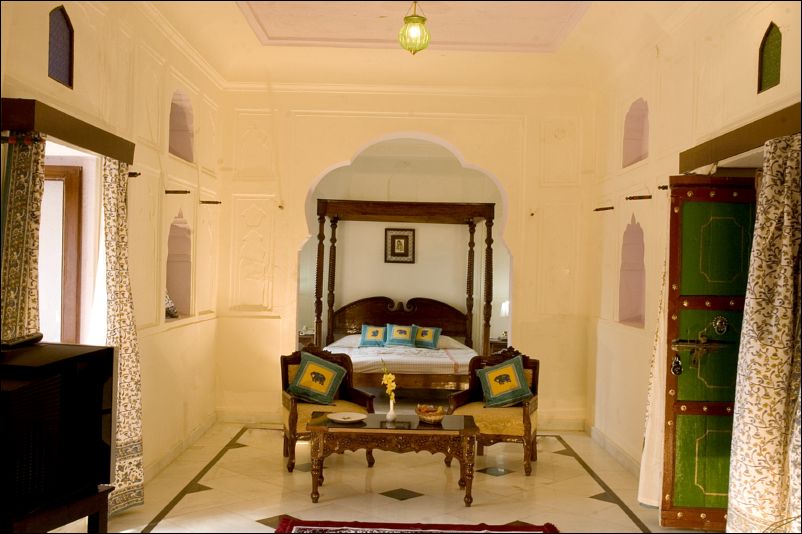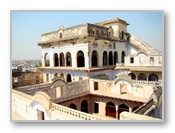MAHALKHAS PALACE, BHARATPUR

Place: Bharatpur, India - Zip / Pin Code: 321001
Description: We have launched a heritage hotel- MAHALKHAS PALACE in Dec. 2008. It is situated in the middle of Lohagarh Fort. Maharaja Suraj Mal built Lohagarh fort in 1733 A.D. Suraj Mal was a great ruler who made a formidable force and played a very important role in the Indian history during 18th century. Maharaja Suraj Mal used all his power and wealth to a good cause, and built numerous forts and palaces in and across his kingdom. In 1753 he sacked Delhi, and in the following years successfully repelled the combined attack of the imperial forces aided by Holkar and Jaipur, and later on signally defeated Holkar at Kumher. His crowning achievement was the capture of Agra in 1761 A.D. (which the Jats held till 1774 A.D.) together with the sovereignty of Agra and Muttra Districts, most of the territory now called Alwar, Rohtak and parts of Gurgaon. Suraj Mal met his death in 1763 and was succeeded by his eldest son Jawahir Singh. Maharaja Jawahir Singh lived chiefly in the Agra palace, where he always prefered to sit on the black marble throne of Jahangir. During the British Empire, the state covered an area of 5,123 sq. km. Its rulers enjoyed a salute of 17 guns. The state acceded unto the domination of India 1947A.D. The Lohagarh Fort, true to its name stood solidly in the face of many British attacks, frosted them to ends. It faced the British onslaught four times and after a long siege they had to withdraw. It is very different from the other forts in the state, there is no flamboyance associated to fort but it generates an aura of strength and magnificence. The fort is surrounded with moat which was previously filled with water to ward off the enemy attacks. The main entrance of this grand fort is the “Ashtadhatu Gate”. Ashtadhatu means eight metals. This north facing imposing gateway with huge rounded bastions and paintings of war elephants carries a unique history. Originally it belonged to the Chittorgarh which was taken to Delhi by Alauddin Khilji. The victorious Jats tore it down from the walls of imperial Delhi during their attack in 1764 and brought it back with them to Bharatpur. The Fort has so many monument within its precincts as Kishori Mahal, Museum, Jawahir Burj, Fateh Burj, Temple of Bihari Ji, Temple of Mohan Ji. etc. MAHAL KHAS PALACE is situated in the middle of Lohagarh Fort. The palace is a fine blend of Mughal and Rajput architecture built in 1826 by Maharaja Balwant Singh, Who was a successor to great Jat ruler Maharaja Surajmal. It had been residential palace of Bharatpur rulers up to 1965. Now it has been converted into a heritage hotel. It has beautifully decorated 15 A/C Rooms, a huge courtyard, beautiful wall paintings, marvelous carvings on sand stone, a fine dining restaurant, many wide open roofs, lobbies and well qualified & trained staff to entertain our valuable guests. All chambers are en suit with ornate pierced stone windows (Jharokas). Bharatpur is famous also for world famous Keoladeo Bird Sanctuary, a paradise for the avian world and the pilgrimage for the bird lovers. This former duck hunting, reserve for the maharajas, is one of the major wintering areas for large numbers of aquatic birds from Afghanistan, Turkmenistan, China and Siberia. The name Keoladeo is derived from the name of an ancient Hindu Temple devoted to Lord Shiva in the sanctuary’s central zone. It was known as the best duck shooting resort in the British Empire, but was declared a reserve for birds in 1956 and later upgraded to National park. UNESCO has listed it as world heritage site.
Total Rooms: 15
Room Facility: It has beautifully decorated 15 A/C Rooms, a huge courtyard, beautiful wall paintings, marvelous carvings on sand stone, a fine dining restaurant, many wide open roofs, lobbies and well qualified & trained staff to entertain our valuable guests.
Room Service: 6 a.m. till 11 p.m.
Location Advantage: MAHAL KHAS PALACE is situated in the middle of Lohagarh Fort
Access Airport: New Delhi- 184 kms,Jaipur -176 kms
Access Rail: Mathura- 39 kms
Number of Rooms: 4
Number of Rooms: 11
- 24-hour front desk
- Banquet facilities
- Bell staff/porter
- Continental breakfast
- 24-hour room service
- Coffee shop
- Internet services
- Secured parking
- Conference facilities
- High speed internet access
- Currency exchange
- Doctor on call
- Door man
- 24-hour security
- Air conditioning
- Housekeeping - daily
- Laundry/Valet service
- Parking
- Restaurant
- Room service
- Safe deposit box
- Security
- Dry cleaning
- Telephone
- Bathroom amenities
- Wake-up calls
- Interstate calls
- Intrastate calls
- Cable television
- Extra adult charge
- Color television
- Computer
- Satellite television
- Double beds
- Internet access
- Balcony/Lanai/Terrace
- Refrigerator


